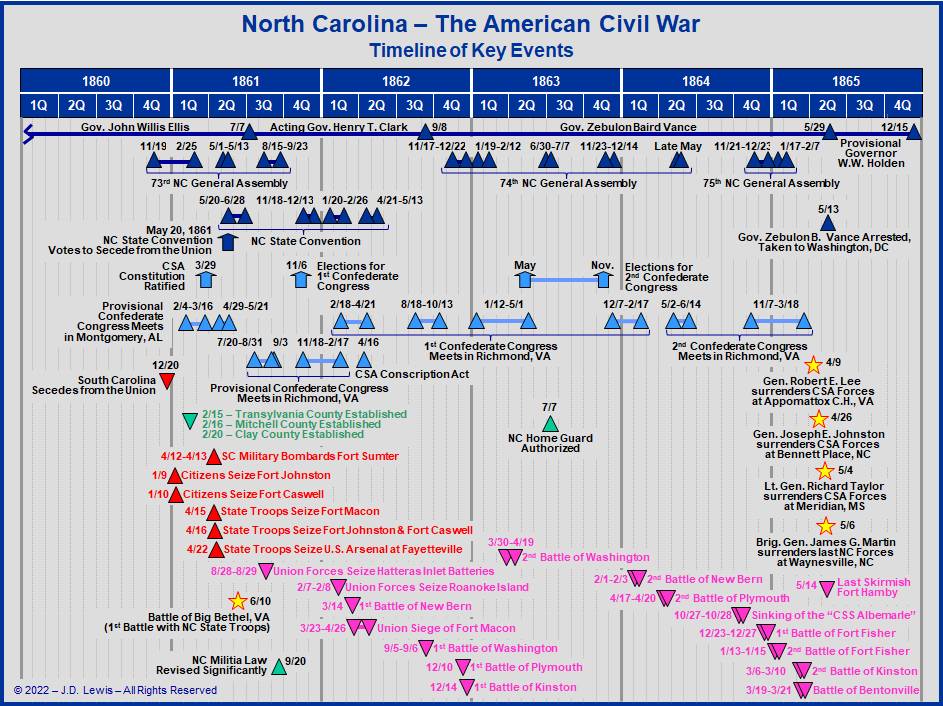 |
||||
|
|
||||
|
|
||
 |
||
|
South Carolina seceded from the Union on December 20, 1860, with more states to follow in early 1861. North Carolina voted to secede on May 20th by the NC State Convention that ran from May 20, 1861 to May 13, 1862. During the war, North Carolina included 89 counties, three (3) of which were approved by the 73rd NC General Assembly in February of 1861, just before the war started. President Abraham Lincoln requested that North Carolina provide 75,000 men to preserve the Union, and it was essentially this "absurd request" that led to the vote for North Carolina's secession. Governor John W. Ellis led the efforts to recruit men for the new Confederate States of America (CSA) Army, and the 1st NC Volunteers (Bethel Regiment) were soon marching to Virginia to assist their CSA brethren - arriving at Richmond on May 21st - one day after North Carolina's vote for secession. The first and only casualty from North Carolina at the Battle of Big Bethel Church on June 10th was Private Henry Lawson Wyatt, who was mortally wounded on the field of battle. In the Virginia volume of the "Confederate Military History," Major Jed Hotchkiss, its author, says: "It is generally admitted that young Wyatt was the first Confederate soldier killed in action in Virginia during the civil war." As that was also the first battle of the war, it may be recorded that Wyatt was the first Confederate soldier killed in battle in that war. Wyatt's body was soon taken off the field by his comrades, who carried him to Yorktown the same night, where he died. He had apparently not recovered consciousness from the time he was struck. His body was carried to Richmond the next day, where he was buried with military honors from the Reverend Mr. Duncan's church. Six more men from the 1st NC Volunteers were wounded at this engagement. North Carolina created 83 regiments of "regular troops" over the course of the American Civil War. 42 additional battalions and almost 100 "independent companies" were created, most merged into larger regiments as time unfolded. Nine (9) battalions and three (3) regiments of Junior Reserves were established, along with eight (8) battalions and five (5) regiments of Senior Reserves, and two (2) battalions and three (3) regiments of Detailed Men. All of these units were assigned to the CSA, most of the "regular troops" being sent to serve in other states, and the Reserves and Detailed Men all serving within the State. North Carolina also created 121 regiment of Militia, plus 20 regiments and 76 battalions of Home Guard during the war - all of these units and men were assigned duties solely within State Borders. Governor Ellis died, unexpectedly, on July 7, 1861, and Henry T. Clark took the reins until Zebulon B. Vance was elected and took the oath of office on September 8, 1862. Vance had served as the Captain in the 4th NC Volunteers (State Troops) and Colonel over the 26th NC Regiment (State Troops) for more than a year; he saw much of the war in Virginia during his military service. On August 26, 1861, Federal Maj. Gen. Benjamin F. Butler with Rear Admiral Silas H. Stringham, departed Hampton Roads, VA with seven (7) warships and about 935 men. They arrived and anchored just off Capt Hatteras on August 27th, in full view of roughly 580 North Carolina defenders within Fort Clark and Fort Hatteras under the command of Col. William F. Martin. Col. Martin immediately called for reinforcements from Forts Ocracoke and Oregon. Unfortunately for him and his garrison, communication among the forts was slow, and the first reinforcements did not arrive until late the next day, when it was too late. The Hatteas Inlet Batteries were taken on August 29th, and the Union forces soon launched more attacks on North Carolina soil. During 1862, Union forces took Roanoke Island, New Bern, Fort Macon near Beaufort, Washington, and Plymouth. They made many incursions all along the coastline and occupied many strategic locations in eastern North Carolina. All-in-all, there were over 300 engagements in North Carolina from August 1861 to May 1865, most minor skirmishes, but still plenty of large-scale seiges and assaults. The Battle of Bentonville - March 19-21, 1865 was the last big fight in North Carolina. Over the course of the American Civil War, North Carolina sent troops to fight in Virginia, West Virginia, Maryland, Pennsylvania, Washington, DC, Tennessee, Kentucky, Georgia, Florida, Alabama, and Mississippi. Several noted historians claimed that North Carolina provided the largest number of men from any other State during the War - almost 250,000. This Author has not tried to validate or challenge this assertion - not within my power or inclination. The North Carolina General Assembly continued to function just as it had prior to the war. Legislation was ratified and enacted. Laws were made and enforced. The NC Supreme Court exercised its power and ruled against existing Militia laws such that the Home Guard had to be created by the Legislature in 1863. Governors used their office and power to keep the State operating under severe circumstances. Gov. Vance was instrumental in promoting "Blockade Runners," and one was named after him - the "Ad-Vance." Most of the North Carolina "regular troops" were with General Robert E. Lee (VA) when he surrenderd at Appomattox Court House, VA on April 9, 1865. Another large number of NC "regular troops" were with General Joseph E. Johnston (VA) when he surrendered at Bennett Place, NC, near Durham Station on April 26, 1865. A small number of NC "regular troops" were with Lt. Gen. Richard Taylor (LA) when he surrendered at Meridian, MS on May 4, 1865. The last handful of "regular troops" were with Brig. Gen. James G. Martin (NC) when he surrendered at Waynesville, NC on May 6, 1865. |
 |
 |
© 2022-2024 - J.D. Lewis - All Rights Reserved